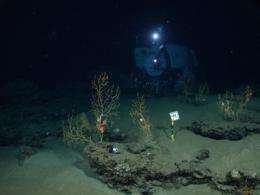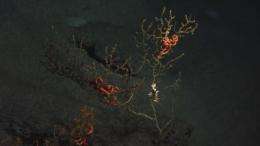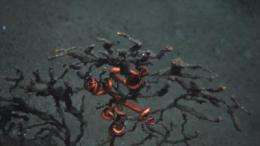Study reveals unprecedented impact of Deepwater Horizon on deep ocean

Scientists report they have "compelling evidence" that the Deepwater Horizon oil spill has impacted deep-sea corals. Their study, published today in the journal Proceedings of the National Academy of Sciences utilized a wide range of underwater vehicles, including the submarine Alvin, to investigate the corals and comprehensive two-dimensional gas chromatography to determine precisely the source of petroleum hydrocarbons found.
The lead author of the study, Assistant Professor of Chemistry Helen White, was part of a diverse team of researchers, led by Charles Fisher from Penn State University, that included Erik Cordes from Temple University and Timothy Shank and Christopher German from Woods Hole Oceanographic Institution (WHOI), which operates the Navy-owned submersible Alvin. Fisher, Cordes, Shank and German are co-authors of the study, along with 10 other scientists from WHOI, Penn State, Temple and the U.S. Geological Survey.
The study's findings are significant for a number of reasons, White says. "These biological communities in the deep Gulf of Mexico are separated from human activity at the surface by 4,000 feet of water. We would not expect deep–water corals to be impacted by a typical oil spill. But the sheer magnitude of the Deepwater Horizon oil spill and its release at depth make it very different than a tanker running aground and spilling its contents. Because of the unprecedented nature of the spill, we have learned that its impacts are more far reaching than those arising from smaller spills that occur on the surface."

The study grew out of an initial research cruise to the Gulf led by Fisher in late October 2010—approximately six months after the Deepwater Horizon oil spill. This expedition was part of an ongoing study funded by the Bureau of Ocean Energy Management and the National Oceanic and Atmospheric Administration's Ocean Exploration and Research program. Using the remotely operated vehicle (ROV) Jason II, the team examined nine sites at distances greater than 20 km from the Macondo Well and found deep-water coral communities unharmed. However, when the ROV explored another area 11 km to the SW of the spill site, the team was surprised to discover numerous coral communities covered in a brown flocculent material and showing signs of tissue damage.
"We discovered the site during the last dive of the three-week cruise," says Fisher, a biologist and the chief scientist of this mission. "As soon as the ROV got close enough to the community for the corals to come into clear view it was clear to me that something was wrong at this site. I think it was too much white and brown, and not enough color on the corals and brittle stars. Once we were close enough to zoom in on a few colonies, there was no doubt that this was something I had not seen anywhere else in the Gulf: an abundance of stressed corals, showing clear signs of a recent impact. This is exactly what we had been on the lookout for during all dives, but hoping not to see anywhere. "
These coral communities were at a depth of 4300 feet deep in close proximity to the Macondo well, which had been capped three months previously after spilling an estimated 160 million gallons of oil into the Gulf. The timing and unprecedented nature of this observation suggested that the visual damage resulted from the Deepwater Horizon oil spill.
The team was determined to find answers. And on December 8, barely a month after returning from sea, the scientists set out on a second cruise to the Gulf. It is rare for researchers to get the opportunity to return to a site so quickly. Making that trip and the subsequent study possible was funding from the National Science Foundation's RAPID Collaborative Research grant program, which aids scientists seeking to respond quickly to urgent issues such as natural disasters or crises resulting from human activity; for example, an oil spill.
Joining this second research cruise, again headed by Fisher, was Helen White, whose expertise as a geochemist was key to the interdisciplinary effort. "It is easy to see the impact of oil on surface waters, coastlines and marine life, but this was the first time we were diving to the seafloor to examine the effects on deep sea ecosystems," says White, who directs the new Tri-College Environmental Studies Program at Haverford College.

To examine the deep water, the team employed the autonomous underwater vehicle Sentry to map and photograph the ocean floor and the deep submergence vehicle Alvin to get a better look at the distressed corals. Alvin holds a pilot and two passengers, and is equipped with viewports and cameras. Alvin also has robotic arms that can manipulate instruments to collect samples. During six dives in Alvin, whose manipulator claws were modified with a cutting blade, the team collected sediments and samples of the corals and filtered the brown material off of the corals for analysis. "Collecting samples from the deep ocean is incredibly challenging, and Alvin is crucial to this kind of work," says White, who got the chance to observe the corals up close onboard the submarine during one of the scheduled dives.
"As a geochemist, my primary aim in this research was to determine the composition of the brown flocculent material covering the corals and the source of any petroleum hydrocarbons present," says White, who brought Catherine Sheline, a Haverford College sophomore chemistry student along with her on the research cruise. Upon returning to Haverford, four other students worked with White in her lab to analyze some of the samples, including chemistry majors Jenine Abbassi and Lindsay Ryan and biology majors Elizabeth Coward and Elizabeth Willis.
Because oil can naturally seep from cracks in the sea floor of the Gulf, pinpointing the source of petroleum hydrocarbons in Gulf samples can be challenging to scientists, especially since oil is comprised of a complex mixture of different chemical compounds. However, there are often slight differences in oils that can be used to trace their origin. To identify the oil found in the coral communities, White worked with Christopher Reddy and Robert Nelson at WHOI using an advanced technique called comprehensive two-dimensional gas chromatography, which was pioneered at WHOI by Reddy and Nelson for use in oil spill research. The method, which separates oil compounds by molecular weight, allows scientists to essentially "fingerprint" oil and determine its source.

This exacting petroleum analysis coupled to the analysis of 69 images from 43 individual corals at the site, performed by Pen-Yuan Hsing, a graduate student of Charles Fisher's at PSU, yielded strong evidence that the coral communities were impacted by oil from the Macondo well spill.
"These findings will have a significant impact on the location of deep water drilling and the monitoring of oil spills in the future," White says. "Ongoing work in the Gulf will improve our understanding of the resilience of these isolated communities and the extent to which they are affected by human activity. Oil had a visible effect on these corals and it is important to determine if they can rebound."
More information: "Impact of the Deepwater Horizon oil spill on a deep-water coral community in the Gulf of Mexico" Proceedings of the National Academy of Sciences (2012).
Journal information: Proceedings of the National Academy of Sciences
Provided by Woods Hole Oceanographic Institution

















